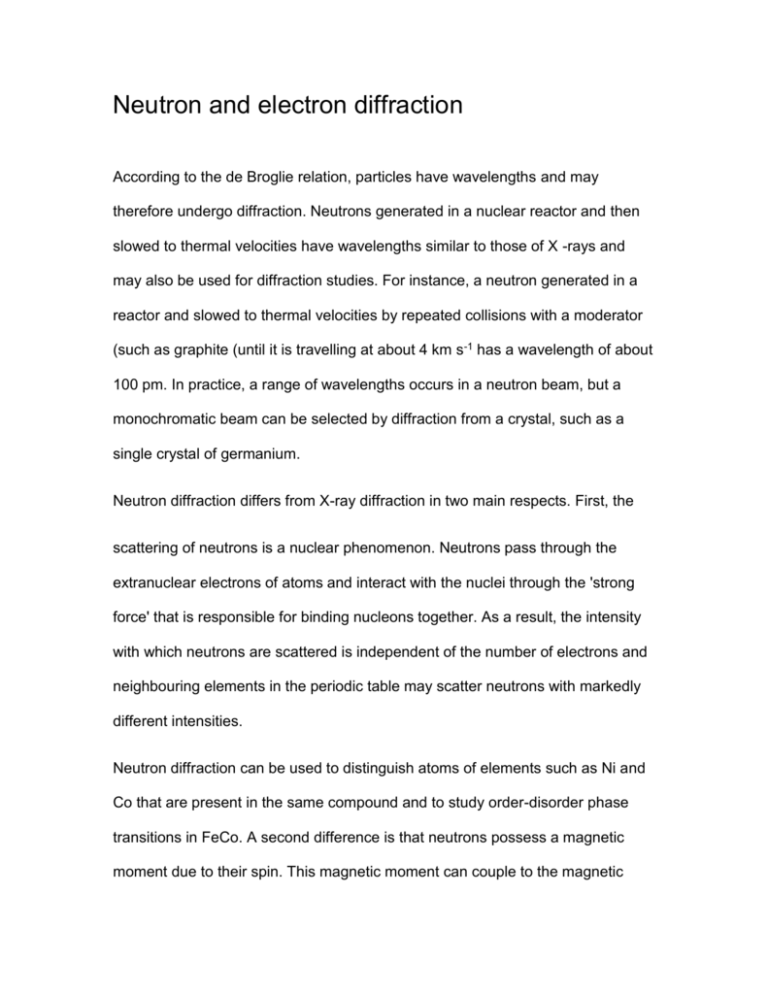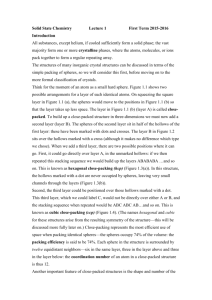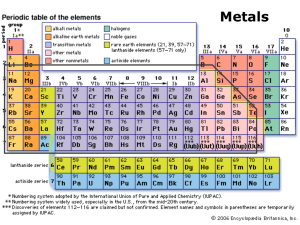Neutron and electron diffraction
advertisement

Neutron and electron diffraction According to the de Broglie relation, particles have wavelengths and may therefore undergo diffraction. Neutrons generated in a nuclear reactor and then slowed to thermal velocities have wavelengths similar to those of X -rays and may also be used for diffraction studies. For instance, a neutron generated in a reactor and slowed to thermal velocities by repeated collisions with a moderator (such as graphite )until it is travelling at about 4 km s-1 has a wavelength of about 100 pm. In practice, a range of wavelengths occurs in a neutron beam, but a monochromatic beam can be selected by diffraction from a crystal, such as a single crystal of germanium. Neutron diffraction differs from X-ray diffraction in two main respects. First, the scattering of neutrons is a nuclear phenomenon. Neutrons pass through the extranuclear electrons of atoms and interact with the nuclei through the 'strong force' that is responsible for binding nucleons together. As a result, the intensity with which neutrons are scattered is independent of the number of electrons and neighbouring elements in the periodic table may scatter neutrons with markedly different intensities. Neutron diffraction can be used to distinguish atoms of elements such as Ni and Co that are present in the same compound and to study order-disorder phase transitions in FeCo. A second difference is that neutrons possess a magnetic moment due to their spin. This magnetic moment can couple to the magnetic fields of atoms or ions in a crystal (if the ions have unpaired electrons) and modify the diffraction pattern. One consequence is that neutron diffraction is well suited to the investigation of magnetically ordered lattices in which neighbouring atoms may be of the same element but have different orientations of their electronic spin (Fig.1). Electrons accelerated through a potential difference of 40 kv have wavelengths of about 6 pm, and so are also suitable for diffraction studies. However, their main application is to the study of surfaces. Fig.1 If the spins of atoms at lattice points are orderly, as in this material, where the spins of one set of atoms are aligned anti parallel to those of the other set, neutron diffraction detects two interpenetrating simple cubic lattices on account of the magnetic interaction of the neutron with the atoms, but X-ray diffraction would see only a single bcc lattice. Example 1 Calculating the typical wavelength of thermal neutrons Self-test 1 Calculate the temperature needed for the average wavelength of the neutrons to be 100 pm. [1.90 x 103 K]. Crystal structure The bonding within a solid may be of various kinds. Simplest of all (in principle) are elemental metals, where electrons are delocalized over arrays of identical cations and bind them together into a rigid but ductile and malleable whole. Metallic solids Most metallic elements crystallize in one of three simple forms, two of which can be explained in terms of hard spheres packing together in the closest possible arrangement. (a) Close packing Figure 2 shows a close-packed layer of identical spheres, one with maximum utilization of space. A close-packed three-dimensional structure is obtained by stacking such close-packed layers on top of one another. However, this stacking can be done in different ways, which result in close-packed polytypes, or structures that are identical in two dimensions (the close-packed layers) but differ in the third dimension. In all polytypes, the spheres of second close-packed layer lie in the depressions of the first layer (Fig. 3). The third layer may be added in either of two ways. In one, the spheres are placed so that they reproduce the first layer (Fig. 4a), to give an ABA pattern of layers. Alternatively, the spheres may be placed over the gaps in the first layer (Fig. 4b), so giving an ABC pattern. Two polytypes are formed if the two stacking patterns are repeated in the vertical direction. If the ABA pattern is repeated, to give the sequence of layers ABABAB . . . , the spheres are hexagonally close-packed Fig. 2 The first layer of close- packed spheres used to build a three-dimensional layer. close-packed structure. component of Fig. 3 The second layer of close- packed spheres occupies the dips of the first The two layers are the AB the close-packed structure. Fig. 4 (a) The third layer of close-packed spheres might occupy the dips lying directly above the spheres in the first layer, resulting in an ABA structure, which corresponds to hexagonal close-packing. (b) Alternatively, the third layer might lie in the dips that are not above the spheres in the first layer, resulting in an ABC structure, which corresponds to cubic close- packing. Table 1 The crystal structures of some elements ………………………………………………………………………………………………………………… … Structure Element ………………………………………………………………………………………………………………… hcp' Be, Cd, Co, He, Mg, Sc, Ti, Zn fcc' (ccp, cubic F) Xe Ag, AJ, Ar, Au, Ca, Cu, Kr, Ne, Ni, Pd, Pb, Pt, Rh, Rn, Sr, bcc (cubic I) Ba, Cs, Cr, Fe, K, Ll, Mn, Mo, Rb, Na, Ta, W, V cubic P Po ………………………………………………………………………………………………………………… . Close-packed structures. (hcp). Alternatively, if the ABC pattern is repeated, to give the sequence ABCABC . . the spheres are cubic dose-packed (ccp). We can see the origins of these names by referring to Fig. 5. The ccp structure gives rise to a face-centred unit cell, so may also be denoted cubic F (or fcc, for face-centred cubic). It is also possible to have random sequences of layers; however, the hcp and ccp polytypes are the most important. Table 1 lists some elements possessing these structures. The compactness of close-packed structures is indicated by their coordination number, the number of atoms immediately surrounding any selected atom, which is 12 in all cases. Another measure of their compactness is the packing fraction, the fraction of space occupied by the spheres, which is 0.740. That is, in a close-packed solid of identical hard spheres, only 26.0 per cent of the volume is empty space. The fact that many metals are close-packed accounts for their high densities. Fig. 5 A fragment of the structure shown in Fig. 4 revealing the (a) hexagonal (b) cubic symmetry. The tints on the spheres are the same as for the layers in Fig4 The packing fraction To calculate a packing fraction of a ccp structure, we first calculate the volume of a unit cell, and then calculate the total volume of the spheres that fully or partially occupy it. The first part of the calculation is a straightforward exercise in geometry. The second part involves counting the fraction of spheres that occupy the cell. Refer to Fig. 6. Because a diagonal of any face passes completely through one sphere and halfway through two other spheres, its length is 4R. The length of a side is therefore 81/2 R and the volume of the unit cell is 83 / 2 R3 . Because each cell contains the equivalent of 6 X 1/2 + 8 x 1/8 = 4 spheres, and the volume of each sphere is 4/3 π R3, the total occupied volume is 16/3 π R3 . The fraction of space occupied is therefore 16/3 π R3 / 8 3/2 R3 =16/3 π / 83 / 2, or 0.740. Because an hcp structure has the same coordination number, its packing fraction is the same. The packing fractions of structures that are not close-packed are calculated similarly. Fig. 6 The calculation of the packing fraction of an ccp unit cell. (b) Less closely packed structures As shown in Table 1, a number of common metals adopt structures that are less than close-packed. The departure from close packing suggests that factors such as specific covalent bonding between neighbouring atoms are beginning to influence the structure and impose a specific geometrical arrangement. One such arrangement results in a cubic I (bcc, for body-centred cubic) structure, with one sphere at the centre of a cube formed by eight others. The coordination number of a bcc structure is only 8, but there are six more atoms not much further away than the eight nearest neighbours. The packing fraction of 0.68 is not much smaller than the value for a close-packed structure (0.74), and shows that about two-thirds of the available space is actually occupied.






